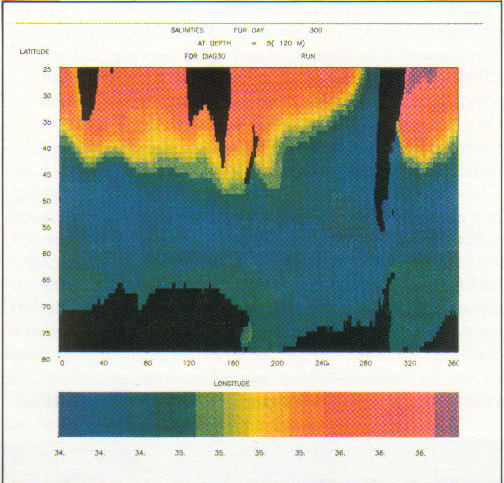

The computing activities under this heading are those that are not attributable to any one Board of SERC. They include the IBM mainframe service at the Atlas Centre at Rutherford Appleton Laboratory (RAL) and the SERC computing and network infrastructure. Both these facilities are used by all Boards. In a broader context the activities include the support and development of the Joint Research Councils' Cray X-MP/48 supercomputing service.
There have been no major changes this year in the computing infrastructure and networking activities. The IBM service has seen substantial activity with the provision of a large new computer and the signing of an agreement with IBM on an initiative in supercomputing. The Cray service is operating very productively, and a report has been produced on scientific results obtained with the help of the supercomputer in its first 18 months of operation.
In April 1988 a new IBM 3090-200E/1VF computer came into service. It took over the roles of two earlier models, an IBM 3081K and and Amdahl Atlas 10. Its power for conventional computing is slightly greater than that of its predecessors, and it has a new Vector Facility which can boost the performance substantially for suitable types of scientific computation. It also has memory facilities much larger than were available on earlier machines. The introduction of the new computer itself went smoothly as far as the user service was concerned, and substantial behind-the-scenes effort has gone into updating the operating systems in order to be able to take advantage of the potential of the new hardware. By the end of the year this work was largely complete.
During the year, a joint study agreement with IBM was signed. This provides for a major collaboration between IBM and RAL on the creation of a centre of excellence for IBM technical computing. It will involve work on the exploitation of vector and parallel processing techniques and on the visualisation of data. As part of the agreement the IBM 3090-200E/1VF is being upgraded to a 3090-600E/6VF, a machine with six scaler processors and six Vector Facilities. Its peak performance is in the region of 70% of that of the Cray X-MP/48 but its memory will be much larger, and many of its facilities nicely complement those on the Cray. The IBM machine will be available for use through the peer review system and also under arrangements for specific collaborations with IBM.
The Cray X-MP/48 supercomputer service, which was inaugurated in 1987, provides a major national computing resource for research workers supported by all Research Councils. By the end of 1988 a total of 154 grant applications to use the facility had been approved and a further 36 applications were awaiting peer review judgement.
The supercomputer is used mainly for the simulation and modelling of complex systems in the natural sciences, and major projects are in progress in physics, chemistry, engineering and the environmental sciences. In some cases the power of the Cray is such that for the first time computations can be done to an accuracy that matches that attainable by measurement, leading to an ability to make confident predictions of related effects that have not been or cannot be measured experimentally. In other more demanding cases the power is sufficient to make major and useful advances on what has been possible before but cannot yet reveal the full detail. There are some systems for which computer modelling is the only possible or realistic means of exploration. The validity of computer modelling as a scientific technique complementary to experimentation and theory is extending gradually across a broad range of disciplines.

A report on Scientific results from the Cray X-MP/48 was issued during the year. It runs to 75 pages plus appendices and lists 64 research papers the content of which is based on work done on the Cray. Traditional supercomputing disciplines are well represented and there are exciting new activities in disease epidemiology, drug design, catalysis, high temperature superconductivity, computational fluid dynamics and other areas.
Highlights include:
The fact that cancer cells have a reduced blood supply is being exploited by designing chemotherapeutic drugs which are active only when reduced.
Simulated annealing and molecular dynamics have been used to speed the refinement of experimental crystallographic data. A 3.3 Angstrom structure of rabbit serum transferring shows for the first time the peptide chains connecting the halves of the bi-lobal molecule.
The CrayX-MP/48 is providing new detailed models of the Antarctic Ocean, the North Sea, the upper atmosphere and global meteorology.
The power of the Cray X-MP/48 makes it possible to construct bias-free analyses of the clustering and geographic distribution of certain human cancers.
New insights into the fundamental behaviour of turbulent fluids are being gained by sophisticated numerical modelling.
Detailed models are being constructed for the elastic-plastic behaviour and void growth at a crack tip.
The power of all four Cray processors has been linked together to extend the range of atoms that can be modelled and to increase the accuracy of atomic collision cross-sections.
A new non-linear self-focusing effect in parallel laser beams has been discovered. This could remove one of the obstacles to developing laser-driven, high-field particle accelerators.